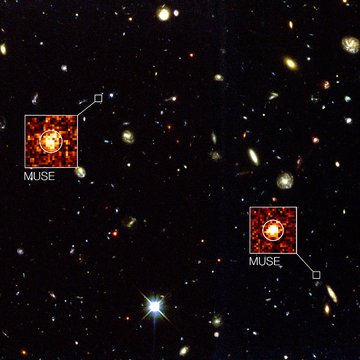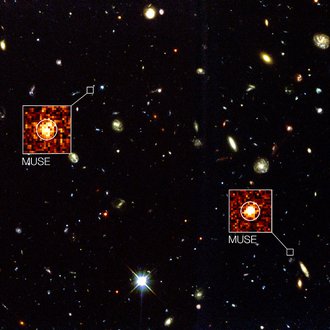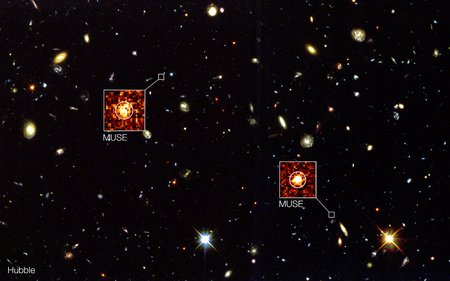ESO: Looking Deeply into the Universe in 3D

The background image in this composite shows the NASA/ESA Hubble Space Telescope image of the region known as the Hubble Deep Field South. New observations using the MUSE instrument on ESO's Very Large Telescope have detected remote galaxies that are not visible to Hubble. Two examples are highlighted in this composite view. These objects are completely invisible in the Hubble picture but show up strongly in the appropriate parts of the three-dimensional MUSE data.
Credit: ESO/MUSE Consortium/R. BaconMUSE goes beyond Hubble
The MUSE instrument on ESO’s Very Large Telescope has given astronomers the best ever three-dimensional view of the deep Universe. After staring at the Hubble Deep Field South region for only 27 hours, the new observations reveal the distances, motions and other properties of far more galaxies than ever before in this tiny piece of the sky. They also go beyond Hubble and reveal previously invisible objects.
Please find more details on the ESO website.

The background image in this composite shows the NASA/ESA Hubble Space Telescope image of the region known as the Hubble Deep Field South. New observations using the MUSE instrument on ESO's Very Large Telescope have detected remote galaxies that are not visible to Hubble. Two examples are highlighted in this composite view. These objects are completely invisible in the Hubble picture but show up strongly in the appropriate parts of the three-dimensional MUSE data.
Credit: ESO/MUSE Consortium/R. BaconMUSE goes beyond Hubble
The MUSE instrument on ESO’s Very Large Telescope has given astronomers the best ever three-dimensional view of the deep Universe. After staring at the Hubble Deep Field South region for only 27 hours, the new observations reveal the distances, motions and other properties of far more galaxies than ever before in this tiny piece of the sky. They also go beyond Hubble and reveal previously invisible objects.
Please find more details on the ESO website.
Images
The background image in this composite shows the NASA/ESA Hubble Space Telescope image of the region known as the Hubble Deep Field South. New observations using the MUSE instrument on ESO's Very Large Telescope have detected remote galaxies that are not visible to Hubble. Two examples are highlighted in this composite view. These objects are completely invisible in the Hubble picture but show up strongly in the appropriate parts of the three-dimensional MUSE data.
Big screen size [1000 x 625, 100 KB]
Original size [1280 x 800, 160 KB]



